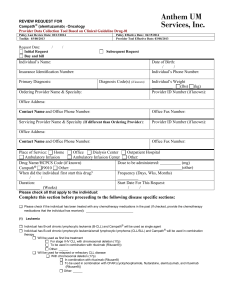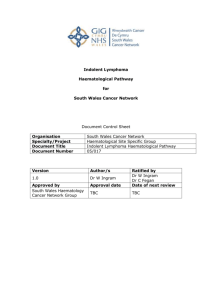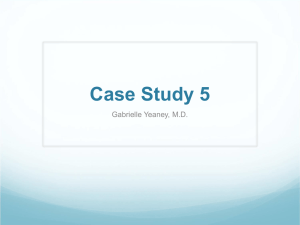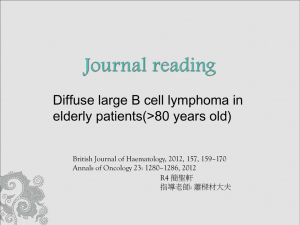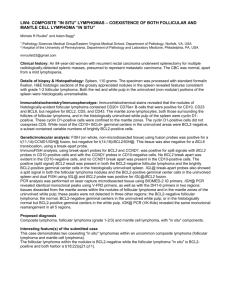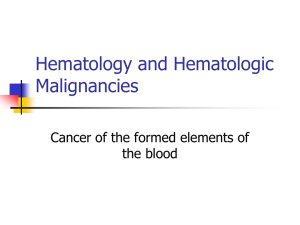ASH 2009: Community Perspectives on Non-Hodgkin`s
advertisement
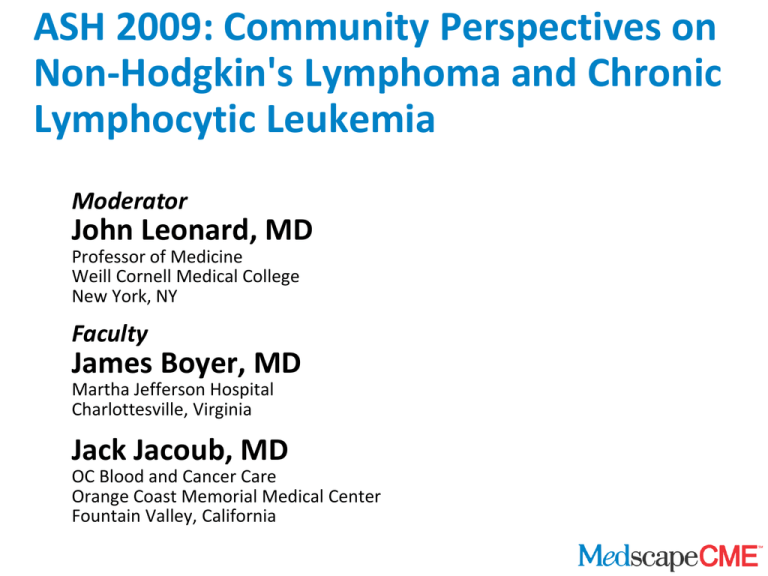
ASH 2009: Community Perspectives on Non-Hodgkin's Lymphoma and Chronic Lymphocytic Leukemia Moderator John Leonard, MD Professor of Medicine Weill Cornell Medical College New York, NY Faculty James Boyer, MD Martha Jefferson Hospital Charlottesville, Virginia Jack Jacoub, MD OC Blood and Cancer Care Orange Coast Memorial Medical Center Fountain Valley, California Activity Goal • Assess key new findings and their clinical relevance in Non-Hodgkin's lymphoma (NHL; particularly follicular lymphoma, diffuse large B-cell lymphoma, and mantle cell lymphoma) and chronic lymphocytic leukemia (CLL) • Examine how these new findings may affect current clinical practice and discuss challenges to implementation of new practices in the community Follicular Lymphoma: Initial Therapy • Choice of initial therapy: B-R vs R-CHOP – B-R was well tolerated in a recent phase 3 trial – Progression-free survival benefit of at least 1 year was shown in patients who received B-R • How does B-R compare with CVP-R? • Is it too early to use B-R in clinical practice? B-R = bendamustine and rituximab; R-CHOP = rituximab plus cyclophosphamide, doxorubicin, vincristine, and prednisone; CVP-R = cyclophosphamide, vincristine, prednisone, and rituximab Rummel MJ, et al. Blood. 2009;114:168. Abstract 405. Follicular Lymphoma: Clinical Experience With Bendamustine • Good experience in relapsed lymphomas – Very active and well tolerated • Some issues associated with dosing • Rapid adoption in the community setting • As a component of up-front treatment – For older patients but most likely not for young, fit patients Follicular Lymphoma: Maintenance Therapy • Common to administer maintenance rituximab after initial induction therapy, even in the first-line setting • This approach is useful when the initial response to therapy is not optimal • Radioimmunotherapy consolidation is an alternative • What is the advantage of maintenance vs treatment at the time of progression? – Rituximab Extended Schedule or Retreatment Trial (RESORT) should provide needed information – Toxicity of long-term rituximab use is a concern Follicular Lymphoma: Radioimmunotherapy Consolidation • Not routinely used in the community and even in some academic centers • Can induce durable remissions • Secondary leukemia is a concern • May be most appropriate in the relapse setting in patients who have shorter remission, especially if older • Cost may be justified, but clinical cost (ie, leukemia risk) is a concern Mantle Cell Lymphoma • Limited randomized data to direct therapy – Intensive therapy appropriate for young, fit vs older patients; targeted agents for older patients • Innovative approaches needed – In patients with mantle cell lymphoma, progression-free survival with B-R was approximately 1 year longer than that with R-CHOPa • Drugs in development – Phosphoinositide-3 kinase inhibitors – Mammalian target of rapamycin inhibitors – Novel proteasome inhibitors a. Rummel MJ, et al. Blood. 2009;114:168. Abstract 405. Large-Cell Lymphoma • CHOP-R-14 vs CHOP-R-21 – Interim analysis of Groupe d'Etude des Lymphomes de l'Adulte (GELA) study in older patients with diffuse large Bcell lymphoma suggest that CHOP-R-14 may be inferior to CHOP-R-21 • Community hematologists are waiting for an advance beyond the CHOP combination – Infusional regimens such as etoposide, prednisone, vincristine, and doxorubicin (EPOCH)? Delarue R, et al. Blood. 2009;114:169. Abstract 406. Chronic Lymphocytic Leukemia: Up-Front Therapy • B-R is a newer choicea – Comparison with fludarabine-based therapy will be important because fludarabine has high toxicity • Other drug options are available depending on chromosomal makeup a. Fischer K, et al. Blood. 2009;114:89. Abstract 205. Therapies for Relapsed/Refractory Chronic Lymphocytic Leukemia • Ofatumumab – Approved for use in fludarabine- and alemtuzumabrefractory CLL – Many community hematologists would consider bendamustine before alemtuzumab because of toxicity – Another treatment tool • Lenalidomide – High response rate in the refractory setting – More data needed, but yet another treatment option Thank you for participating in this activity. To proceed to the online CME test, click on the Earn CME Credit link on this page.

